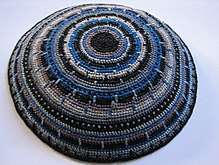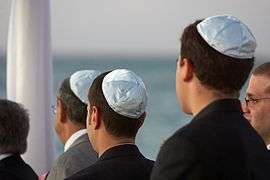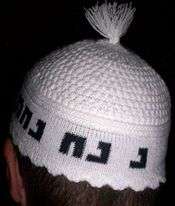Kippah
A kippah (/kɪˈpɑː/, /kiˈpɑː/); also spelled as kippa, kipa, kipah; Hebrew: כִּיפָּה, plural: כִּיפּוֹת kippot; Yiddish: קאפל koppel), or yarmulke (/ˈjɑːrməlkə/, ![]()
Etymology
The term kippah (Hebrew: כיפה) literally means "dome", as the kippah is worn on the head like a dome. The Yiddish term yarmulke might be derived from Polish jarmułka,[1] although it is often associated with an Aramaic phrase (ירא מלכא) meaning "fear the King".[2] Another suggested etymology of yarmulke is the Latin word for an ecclesiastical hood worn in the medieval church.[3]
Keppel or koppel is another Yiddish term for the same thing.[4]
Jewish law
There is debate among Halachic authorities as to whether wearing a kippah at all times is required.[5] According to the Rambam, Jewish law dictates that a man is required to cover his head during prayer.[6]
However, according to some authorities, it has since taken on the force of law because it is an act of Kiddush Hashem (lit., "sanctification of the Name", referring to actions which bring honor to God).[7] The 17th-century authority Rabbi David HaLevi Segal (The "Taz") suggested that the reason was to distinguish Jews from their non-Jewish counterparts, especially while at prayer. He held that nowadays, wearing a kippah is required by halacha.[5]
Other halachic authorities like Sephardi posek, the Chida (Rabbi Chaim David Yosef Azulai), hold that wearing a head covering is a midat hasidut, an additional measure of piety.[5] In a recent responsum, former Sephardic Chief Rabbi of Israel Ovadia Yosef ruled that it should be worn to show affiliation with the religiously observant community.[8]
The Talmud states, "Cover your head in order that the fear of heaven may be upon you."[9] Rabbi Hunah ben Joshua never walked 4 cubits (6.6 feet, or 2 meters) with his head uncovered. He explained: "Because the Divine Presence is always over my head."[10] This was understood by Rabbi Yosef Karo in the Shulchan Arukh as indicating that Jewish men should cover their heads, and should not walk more than four cubits bareheaded.[11] Covering one's head, such as by wearing a kippah, is described as "honoring God".[12] The Mishnah Berurah modifies this ruling, adding that the Achronim established a requirement to wear a head covering even when traversing fewer than four cubits,[13] and even when one is standing still, indoors and outside.[14] Kitzur Shulchan Aruch cites a story from the Talmud (Shabbat 156b) about Rav Nachman bar Yitzchak, who might have become a thief had his mother not saved him from this fate by insisting that he cover his head, which instilled in him the fear of God.[15] In Orthodox communities, boys are encouraged to wear a kippah from a young age in order to ingrain the habit.[16]

The Talmud also implies that unmarried men did not wear a kippah:
- Rabbi Hisda praised Rabbi Hamnuna before Rabbi Huna as a great man. He said to him, 'When he visits you, bring him to me.' When he arrived, he saw that he wore no head-covering. 'Why do you not have head-covering?', he asked. 'Because I am not married', was the reply. Thereupon, he [Rabbi Huna] turned his face away from him, and said, 'See to it that you do not appear before me again before you are married.'[17]
The Tanakh implies that covering one's head is a sign of mourning:
And David went up the ascent of the Mount of Olives, and wept as he went, and his head was covered and he walked barefoot. Then all the people who were with him each covered his head and went up weeping as they went.
[Judah mourns,] and their nobles send their lads for water: they come to the pits, and find no water; their vessels return empty; they are ashamed and confounded, and cover their heads. Because of the ground which is cracked, for there hath been no rain in the land, the plowmen are ashamed, they cover their heads.
The argument for the kippa has two sides. The Vilna Gaon said one can make a berakhah without a kippah, since wearing a kippah is only a midos chassidus ("exemplary attribute"). Recently, there has been an effort to suppress earlier sources that practiced this leniency, including erasing lenient responsa from newly published books.[18]
According to Rabbi Isaac Klein, a Conservative Jew ought to cover his head when in the synagogue, at prayer or sacred study, when engaging in a ritual act, and when eating.[19] In the mid-19th century, Reformers led by Isaac Wise completely rejected the kippot after an altercation in which Rabbi Wise's kippah was knocked off his head.[20]
There is still debate about whether wearing a Kippah is Halachic law or simply a custom. Many Sephardic Jews wear a kippah only when praying and eating.
Types and variation

In the Middle Ages in Europe, the distinctive Jewish headgear was the Jewish hat, a full hat with a brim and a central point or stalk. Originally used by choice among Jews to distinguish themselves, it was later made compulsory in some places by Christian governments as a discriminatory measure. In the early 19th century in the United States, rabbis often wore a scholar's cap (large saucer-shaped caps of cloth, like a beret) or a Chinese skullcap. Other Jews of this era wore black pillbox-shaped kippot.
Often, the color and fabric of the kippah can be a sign of adherence to a specific religious movement, particularly in Israel. Knitted or crocheted kippot, known as kippot serugot, are usually worn by Religious Zionists and the Modern Orthodox,[21] who also wear suede or leather kippot. Members of most Haredi groups wear black velvet or cloth kippot.
More recently, kippot have been observed made in the colors of sports teams, especially football. In the United States, children's kippot with cartoon characters or themes such as Star Wars are popular. (In response to this trend, some Jewish schools have banned kippot with characters that do not conform to traditional Jewish values.[22]) Kippot have been inscribed on the inside as a souvenir for a celebration (bar/bat mitzvah or wedding). Kippot for women are also being made and worn.[23][24][25] These are sometimes made of beaded wire to seem more feminine.[26] A special baby kippah has two strings on each side to fasten it and is often used in a brit milah ceremony.[27]
Samaritans once wore distinctive blue head coverings to separate them from Jews who wore white ones, but today, they more commonly wear fezes with turbans similar to that of Sephardi Jews from the Middle East and North Africa. Today, Samaritans do not usually wear head coverings, except during prayer, Sabbath, and religious festivals.
| Image | Type | Movement |
|---|---|---|
 |
Crocheted | Religious Zionism, Modern Orthodox, Conservative Judaism, Reform Judaism |
| Suede | Modern Orthodox,[24] Conservative Judaism,[28] Reform Judaism[28] | |
| Terylene[29] | Yeshivish, Hasidic, Haredi, Lubavitch – Popular among Rabbis teaching in yeshivas and seminaries | |
 |
Black velvet | Yeshivish, Hasidic, Haredi[30] |
 |
Satin | Conservative Judaism, Reform Judaism |
 |
White crocheted | Many Jerusalemites wear a full-head-sized, white crocheted kippah, sometimes with a knit pom-pom or tassel on top. The Na Nach subgroup of the Breslov Hasidim, followers of the late Rabbi Yisroel Ber Odesser, wear it with the Na Nach Nachma Nachman Meuman phrase crocheted in or embroidered on it.[31] |
 |
Bukharan[32] | Popular with children,[23][32] and also worn by some Sephardi Jews, as well as liberal-leaning and Reform Jews.[33] |
 |
Yemenite | Typically stiff, black velvet with a 1–2 cm. embroidered strip around the edge having a multi-colored geometric, floral, or paisley pattern. |
Head coverings in ancient Israelite culture
The Israelites on Sennacherib's marble relief appear with headdress, and although the ambassadors of Jehu on the Shalmaneser stele have head coverings, their costume seems to be Israelite. One passage of the older literature is of significance: I Kings 20:31 mentions חֲבָליִם havalim, which are placed around the head. This calls to mind pictures of Syrians on Egyptian monuments, represented wearing a cord around their long, flowing hair, a custom still followed in Arabia.
Evidently the costume of the poorest classes is represented; but as the cord gave no protection against the heat of the sun, there is little probability that the custom lasted very long. Much more common was the simple cloth skullcap, dating back to Egyptian times when those of high society routinely shaved their heads, to prevent lice. Conversely, their skullcaps also served as protection against irritation from their wigs.
The Israelites might have worn a headdress similar to that worn by the Bedouins, but it is unknown whether a fixed type of headdress was utilized. That the headdress of the Israelites might have been in the fellah style may be inferred from the use of the noun צַנִיף tzanif (the verb tzanaf meaning "to roll like a ball", Isaiah 22:18) and by the verb חַבָּש habash ("to wind", comp. Ezekiel 16:10; Jonah 2:6). As to the form of such turbans, nothing is known, and they may have varied according to the different classes of society. This was customary with the Assyrians and Babylonians, for example, whose fashions likely influenced the costume of the Israelites—particularly during and after the Babylonian Exile.[34] In Yemen, the wrap around the cap was called מַצַר matzar; the head covering worn by women was a גַּרגוּש gargush.[35]
Civil legal issues
In Goldman v. Weinberger, 475 U.S. 503 (1986), the United States Supreme Court ruled in a 5–4 decision that active military members were required to remove the yarmulke indoors, citing uniform regulations that state only armed security police may keep their heads covered while indoors.[36]
Congress passed the Religious Apparel Amendment after a war story from the 1983 Beirut barracks bombing about the "camouflage kippah" of Jewish Navy Chaplain Arnold Resnicoff was read into the Congressional Record.[37] Catholic Chaplain George Pucciarelli tore off a piece of his Marine Corps uniform to replace Resnicoff's kippah when it had become blood-soaked after being used to wipe the faces of wounded Marines after the 1983 Beirut barracks bombing.[38] This amendment was eventually incorporated into U.S. Department of Defense (DOD) regulations on the "Accommodation of Religious Practices Within the Military Services".[39]

This story of the "camouflage kippah" was re-told at many levels,[40] including a keynote speech by President Ronald Reagan to the Baptist Fundamentalism Annual Convention in 1984,[41] and another time during a White House meeting between Reagan and the American Friends of Lubavitch.[42] After recounting the Beirut story, Reagan asked them about the religious meaning of the kippah.[42] Rabbi Abraham Shemtov, the leader of the group, responded: "Mr. President, the kippah to us is a sign of reverence." Rabbi Feller, another member of the group, continued: "We place the kippah on the very highest point of our being—on our head, the vessel of our intellect—to tell ourselves and the world that there is something which is above man's intellect: the infinite Wisdom of God."[42]
Passage of the Religious Apparel Amendment and the subsequent DOD regulations were followed in 1997 by the passing of the Religious Freedom Restoration Act (RFRA). However, the Supreme Court struck down RFRA as beyond Congress' powers to bind the states in the 1997 case City of Boerne v. Flores. RFRA is constitutional as applied to the Federal government, as seen in Gonzales v. O Centro Espirita Beneficente Uniao do Vegetal.
The Religious Land Use and Institutionalized Persons Act of 2000 (RLUIPA), 114 Stat. 804, 42 U. S. C. §2000cc-1(a)(1)-(2), upheld as constitutional in Cutter v. Wilkinson, 44 U.S. 709 (2005), requires by inference that Orthodox Jewish prisoners be reasonably accommodated in their request to wear yarmulkas.[43]
The French government banned the wearing of kippot, hijabs, and large crosses in public primary and secondary schools in France in March 2004.[44]
The provincial government of Quebec, Canada passed "An Act respecting the laicity of the State" in June 2019, which prohibits the wearing of "religious symbols" by government employees including teachers, police officers, judges, prosecutors, and members of certain commissions.[45]
Wearing by non-Jews
Though it is not required, when a non-Jew wears a kippah in a synagogue, it is considered a sign of respect.[46] Yarmulkes are often provided to guests at a Bar or Bat Mitzvah.[47] They are also often provided at bereavement events and at Jewish cemeteries. According to the Conservative Committee on Jewish Law and Standards, there is no halakhic reason to require a non-Jew to cover their head, but it is recommended that non-Jews be asked to wear a kippah where ritual or worship is being conducted, both out of respect for the Jewish congregation and as a gesture of respectfully including the non-Jewish guest.[48]
Kippahs were adopted as a symbol by some of the non-Jewish African American marchers in the 1965 Selma to Montgomery marches,[49] most prominently by James Bevel.[50]
See also
| Wikimedia Commons has media related to Kippah. |
| Look up kippah in Wiktionary, the free dictionary. |
- Taqiyah (cap), a similar Muslim skullcap
- Zucchetto
- The Philippi Collection
- Kid Yamaka, Jewish American boxer
- Knit cap
- Srugim, an Israeli television show based named after the knit Kippah worn by Religious Zionists
References
- Etymonline.com
- Gwynne, Paul (2017). World Religions in Practice: A Comparative Introduction (2 ed.). John Wiley & Sons. ISBN 9781118972274.
- Gold, David L. 1987. The Etymology of the English Noun yarmlke ‘Jewish skullcap’ and the Obsolescent Hebrew Noun yarmulka ‘idem’ (With An Addendum on Judezmo Words for ‘Jewish Skullcap’). Jewish Language Review 7:180-99; Plaut, Gunther. 1955. The Origin of the Word "Yarmulke." Hebrew Union College Annual 26:567-70.
- http://www.jewish-languages.org/jewish-english-lexicon/words/1534
- "Wearing a Kippa". Daily Halacha. Rabbi Eli Mansour. Retrieved 8 December 2011.
- Mishneh Torah, Ahavah, Hilkhot Tefilah 5:5.
- Shulchan Arukh, Orach Chayim 2:6.
- Yosef, Chief Rabbi Ovadia. Responsa Yechavei Da'ath.
- Shabbat 156b.
- Kiddushin 31a.
- Shulchan Aruch, Orach Chaim, 2:6.
- Shaar HaTzion, OC 2:6.
- Be'er Heitev, Orach Chaim 2:6, note 4, who quotes the Bach, Taz, and the Magen Avraham.
- Mishnah Berurah 2:6, note 9, 10
- KSA 3:6
- Be'er Heitev, OC 2:6, note 5
- Tractate Kiddushin 29b
- "Yarmulke: A historic cover up?" (PDF). Flatbush Journal of Jewish Law.
- Klein, Isaac. A Guide to Jewish Religious Practice, New York: Jewish Theological Seminary of America, 1979.
- Scharfman, Rabbi Harold (1988). The First Rabbi. Pangloss Press.
- Boyarin, Jonathan. Thinking in Jewish, University of Chicago Press, 1996, p. 51. ISBN 0-226-06927-3.
- Lifestyle; "The Yarmulke Is Now a Fashion Item", The New York Times, 23 Sept 1990
- Elliman, Wendy (July 7, 2006). "A guide to Jewish head-coverings: Kippot no longer only come in one style, but a medley of colors, shapes and designs". Jewish Independent. Archived from the original on March 9, 2012.
- Living Jewish – Jewish Attire!, Mazor Guide. Retrieved December 19, 2010.
- "California firm offers kippot for women", The Jerusalem Post, July 10, 2005
- "Ask the Expert: Can Women Wear Kippot?" ‘’My Jewish Learning’’
- "From baby kippah to Tylenol, Bris Kit has everything but the implement", J Weekly, 18 Jun 2004
- "Kippah". My Jewish Learning. 2014-01-31. Retrieved 2017-04-22.
- "Archived copy". Archived from the original on 2014-03-01. Retrieved 2014-02-25.CS1 maint: archived copy as title (link)
- Barring violence, The Jerusalem Post, Yigal Grayeff, February 9, 2006
- On New Year, thousands flock to Rabbi Nachman's grave in Ukraine, HaAretz, Yair Ettinger
- Hats Off To Fashion: Yarmulkes go beyond basic black, Traverse City Record-Eagle, Associated Press, April 13, 2008
- Kippah Couture, The Forward, Angela Himsel, September 29, 2006
- "Head-dress", Jewish Encyclopedia
- "Clothing of the Yemenite Jews" Archived 2006-02-20 at the Wayback Machine, Chayas.com
- "Goldman v. Weinberger". www.oyez.org. IIT Chicago-Kent College of Law.
- Congressional Record, 100th Congress, 11 May 1987.
- "Solarz Passes Religious Apparel Amendment", The Jewish Press, 22 May 1987.
- "Accommodation of Religious Practices Within the Military Services", Department of Defense Instruction
- Bonko, Larry. "Rabbi's Camouflage Yarmulke Woven With Tragedy, Heroism", Norfolk Ledger-Star, 13 January 1984.
- "Remarks at the Baptist Fundamentalism Annual Convention". The American Presidency Project. 13 April 1984. Retrieved 20 April 2013.
- "Rabbis Explain 'Top to Top'". Wellsprings (No. 12 (Vol 2, No. 7)). Lubavitch Youth Organization. August–September 1986.
- Benning v. Georgia, 391 F3d 1299
- French Senate backs headscarf ban, BBC News, 3 March 2004.
- "Quebec government adopts controversial religious symbols bill". CBC News. 16 June 2019. Retrieved 18 June 2019.
- Artson, Bradley Shavit (1998). Jewish Answers to Real-Life Questions. Torah Aura Productions. p. 23. ISBN 9781881283294.
- Marjabelle Young, Stewart (1997). The New Etiquette. Macmillan. p. 21.
- Stein, Jay M. (2009). "Non Jews and Kippah in the Synagogue" (PDF). Committee on Jewish Law and Standards. Cite journal requires
|journal=(help) - "Negro Marchers from Selma Wear 'Yarmulkes' in Deference to Rabbis". Jewish Telegraphic Agency. Retrieved 2017-12-25.
- Lucks, Daniel S. (2014-03-19). Selma to Saigon: The Civil Rights Movement and the Vietnam War. University Press of Kentucky. p. 187. ISBN 9780813145099.

